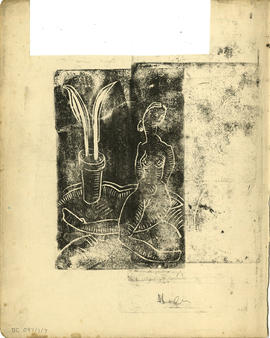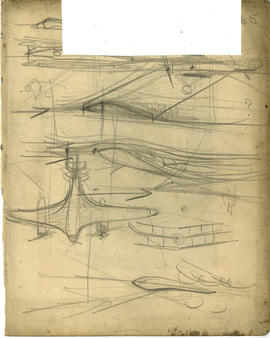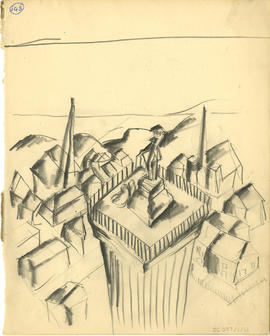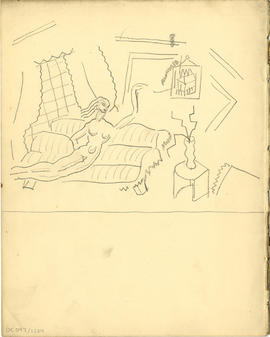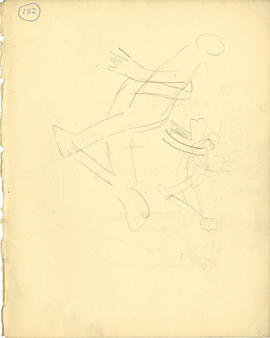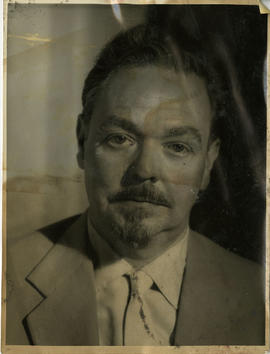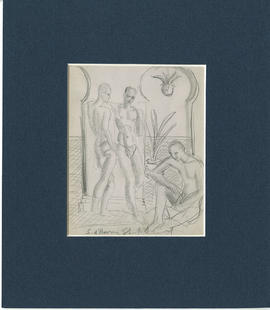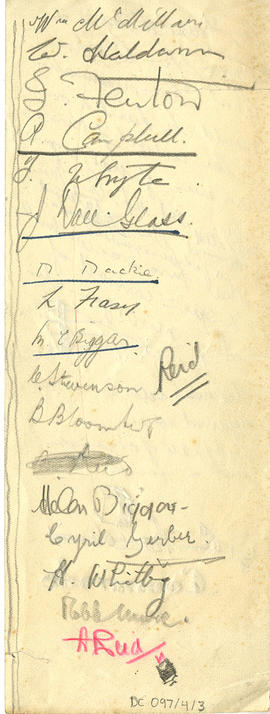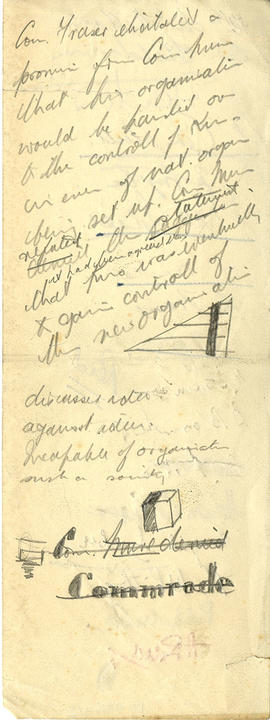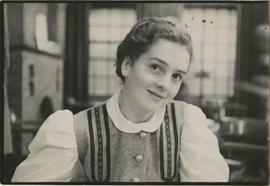Key Information
Reference code
Title
Date(s)
- 1886-1993 (Creation)
Level of description
Collection
Extent
0.3 linear metres
Content and Structure
Scope and content
The collection includes material related to Helen Biggar, Sydney d'Horne Shepherd, Hugh Biggar, and the Kino Film Group.
Appraisal, destruction and scheduling
Accruals
System of arrangement
General Information
Name of creator
Biographical history
Helen Biggar was born on 25 May 1909 in Glasgow, Scotland and died suddenly on 28 Mar 1953 at age 43 in London, England. She was the eldest of three girls; her two younger sisters were named Mary (Mamie) and Florence (Flossie). She was known for being active, determined, beautiful, attractive, tiny, courageous, humorous, radiant, colourful, charming, intelligent, affectionate, loyal, compassionate, and interested in large social issues. She played the violin and knew Russian.
A series of accidents left her short in stature and with a humped back which was considered to be disabled. She was likely only around 4'9". At a young age, she had an operation to remove a tuberculosis gland in her neck. As a young infant later on, she fell off the couch damaging her spine and consequently, had to live in a spinal carriage for a while. Doctors believed she would be paralyzed forever but she eventually learned to walk again. Finally, at the age of 7, she was pushed on stairs damaging her spine again and had to wear a spinal jacket. She learned how to walk again for the third time after this event. She had also suffered from polio.
She transferred to a private school after the stairs accident, then later transferred to The Glasgow School of Art (GSA) at age 16 in 1926 because she showed an affinity for the arts. She was a student at the GSA from 1925 to 1932. At The Glasgow School of Art, she studied heraldry and textile design. She made designs for the Corporation of Glasgow Museums and Art Galleries. She was involved in life-drawings, fashion, plant drawings, cartoons, stage design, and book illustrations. She was awarded a diploma in Textile Design in 1929. She started a two-year sculpture post-grad course but never finished it and left the school in 1931. Ceramics were Helen's favourite form of art. She made illustrations for a fairy story called "Red Shoes" and "The Forerunner" by Dimitri Merezhkovsky who was a historical novelist and symbolist. Regarding extracurriculars at the GSA, she made designs for the school cabaret group and would often attend theatre productions. She also went to the GSA school balls despite not being able to dance. In 1930, she won a £10 Minor Traveller Award for modelling which would be worth roughly £835 in 2023.
Regarding her clothing, as a child, she had made clothes for her dolls. Whilst at GSA, Helen began to make her own clothes. This included wearing long wide trousers or long skirts to disguise her thin legs, even when hemlines were shortening, and was one of first girls to wear trousers in her program. She also dressed in full-sleeve blouses to hide her deformity and liked wearing sandals. She often wore long skirts or dresses to the school balls.
She lived on St. Vincent St in Glasgow which had a studio for her to work in. Often, she would frequent Charles Rennie Macintosh buildings.
Helen was very active in politics. She was a member of the Independent Labour Party in Great Britain. She was also a member of the Communist Party of Great Britain. Her uncle, John Biggar was a politician with the Scottish Labour Party and was Lord Provost of Glasgow between 1941 to 1943. She was also politically active during the Second World War.
She joined the Kino Film Society and GSA Kinecraft Society with Norman McLaren and produced numerous films starting in approximately 1933. He also had studied at GSA. Many of the Kino films were politically influenced. She was also involved in the Glasgow Worker’s Theatre Group.
Helen Biggar's wartime Glasgow art circle included refugee artists like Josef Herman and Jankel Adler, and talented locals like Robert Frame and Eli Montlake, some of whom joined her in London when she moved there permanently in 1945. They exhibited as the New Scottish Group at the Edinburgh Festival in 1947; and as the Gorbals Artists when Glasgow Unity brought their famous production of The Gorbals Story (1946) to London in 1948. On 11 Oct 1948 Helen Biggar married Eli Montlake at Wandsworth register office.
In 1945, she moved to London, living near the British Museum, she found work as a milliner for a French owned business and started making fancy hats for high society ladies. In 1950, she became a wardrobe mistress for Saville Theatre in London for a season of Jewish plays. Later on in the year, she joined and toured with the Ballet Rambert as a wardrobe mistress where she designed and made costumes.
Unfortunately, on 28 Mar 1953, Helen suffered a brain haemorrhage and was rushed St Mary Abbots Hospital in London. She fell into a coma and died soon after. Her cremation at Golders Green was attended by luminaries from the artistic, theatrical, and ballet worlds of London and Glasgow. She was survived by her husband.
Helen Biggar had a niece named Anna Shepherd. Anna was the daughter of Helen’s sister Flossie and Sydney d’Horne Shepherd. Anna published a novel about Helen in 2014 called Helen Unlimited: A Little Biggar. She also wrote an unpublished novel called Traces Left which was used as the primary source for the Birmingham Film and Video Workshop film called “Traces Left.” This 1983 documentary traced Helen’s work as a sculptor, film maker, and set designer. It also highlighted her work with Norman McLaren, the Glasgow Unity Theatre Group, and Glasgow Kino Group, an independent and politically active film production group. From Nov 2022 to Mar 2023, part of Biggar's GSA archive collection, including a drawing, a letter, some newspaper clippings, and the Kino Film Group minute book, were featured at the GLEAN exhibition in the Edinburgh City Art Centre.
Name of creator
Biographical history
Sydney d’Horne Shepherd was born in 1909 in Dundee, Scotland. He was also referred to as Toby Shepherd. He died in 1993. He was a painter, printmaker, and teacher.
Regarding school, he attended Harris Academy in Dundee. He later attended the Dundee School of Art from 1924 to 1926, then went to the Glasgow School of Art (GSA) the following year. He studied at the GSA from 1927 to 1930. He won a travelling scholarship and various prizes for his portraiture and landscape design. He was awarded a Diploma in Drawing and Painting from the GSA on 26 Jun 1929.
In 1929, Helen Biggar and her sister, Florence (Flossie) Biggar met Sydney when he was a student-lecturer. Flossie and Sydney married on 18 Jul 1933 but divorced in 1945. They were nicknamed ‘Tobias and the Angel.’ He is also the cousin of the author Gordon Daviot who wrote the play titled “Queen of Scots.” Later on in his life, he lived in Rudgwick, Sussex in England. He had a daughter, Anna Shepherd.
Regarding his work, he seemed to move around often. He taught at the GSA from 1930 to 1932 then he went to London for various portrait commissions. From 1937 to 1947, he lectured at the Shoreditch Training College in London. He also was part of the National Fire Service during the Second World War from 1941 to 1945. After 1954, he taught at numerous schools but notably Ealing School of Art, St Martin’s School of Art, and Sir John Cass School of Art before he retired in 1974.
His art has been exhibited in numerous countries including Scotland, England, America, Italy, and South Africa. As well, he exhibited at the Royal Society of British Artists, New English Art Club, London Group, Leicester Galleries, Redfern Gallery, Royal Scottish Academy, Society of Scottish Artists, and more. His work is also in the collections of the Queens Gallery in Dundee and the V&A Museum. In 2009, there was an exhibition to mark the centenary of his birth and celebrate his art which was held at the Queens Gallery in Dundee.
Name of creator
Biographical history
The independent film production group Kino Film Group had their foundations rooted in Collet’s Bookstore which was established in 1933 and had various locations worldwide. It helped influence and establish a political community. The bookshop was a left-wing, revolutionary, and progressive source for socialist publications specializing in Russian, Eastern European, and Chinese materials. They held both English and foreign language works. The bookstore expanded throughout the world and became a hub for left-wing discussion and activism. On 19 Dec 1934, a Collet’s Bookstore opened in Glasgow at 229 High Street. The group is also referred to as Glasgow Kino. They were radically political in a very busy time period. They experimented with different styles and techniques of filmmaking.
Both Norman McLaren and Helen Biggar were members of the independent Kino Film Group. The two individuals had shared interests in left wing politics and worked together on various films. They had received support from trade unions for the Glasgow location. Helen Biggar had also worked at Collet's for a period.
Helen and Norman’s most famous film, an anti-war propaganda film, was titled “Hell Unltd.” It included blunt messages about anti-war sentiments, avoiding setting nations against each other, not spending money on weaponry, and refusing to fight. It included puppets, diagrams, animation, and live action elements. On 21 Apr 1936, Norman got the idea for the movie which he shared with Helen and they commenced the writing, editor, and producing for the film. After the Spanish Civil War broke out on 17 Jul 1936, Helen went down to the Kino Film Group in London hoping that they would accept their new film for distribution which they did. It was shown in England, Scotland, and America and won many awards.
Archival history
Custodial history
Donated in 2014 accession reference number Acc 179.
Physical Description and Conditions of Use
Conditions governing access
Glasgow School of Art Archives and Collections are open for research by appointment. For further details, please refer to our Access Policy @ https://gsaarchives.net/policies
Conditions governing reproduction
Application for permission to reproduce should be submitted to The Archives and Collections at The Glasgow School of Art.
Reproduction subject to usual conditions: educational use and condition of material.
For further details, please refer to our Reprographic Service Guide @ https://gsaarchives.net/policies
Language of material
Script of material
Language and script notes
Physical Description
Finding aids
Related Material
Existence and location of originals
Existence and location of copies
Related materials
Notes area
Alternative identifier(s)
Keywords/Tags
Place access points
People and Organisations
- Biggar, Hugh (Subject)
- Biggar, Helen Manson (Subject)
- Shepherd, Sydney d'Horne (Subject)
- Glasgow Kino Film Group (Subject)
Genre access points
Status
Level of detail
Processing information
- Initial description created by Carrie Skinner, Archives and Colletions Documentation Assistant in 2017, updated by Susannah Waters, Archives and Collections Manager 01/03/2018.
- Catalogue exported from Archon and imported into AtoM during system migration, 2018-2019.
Language(s)
- English
Script(s)
Sources
Archivist's note
© Copyright 2018 GSA Archives. All rights reserved.


